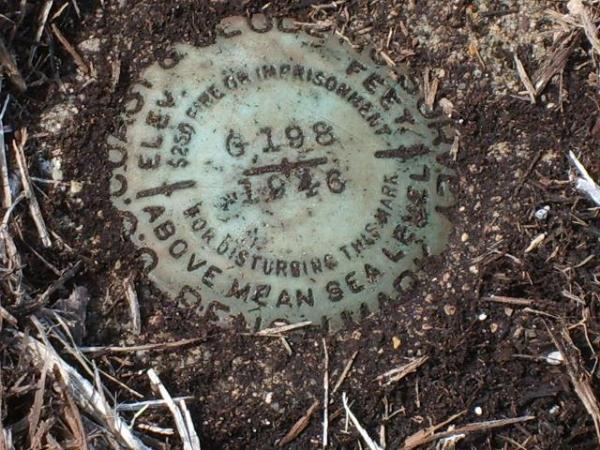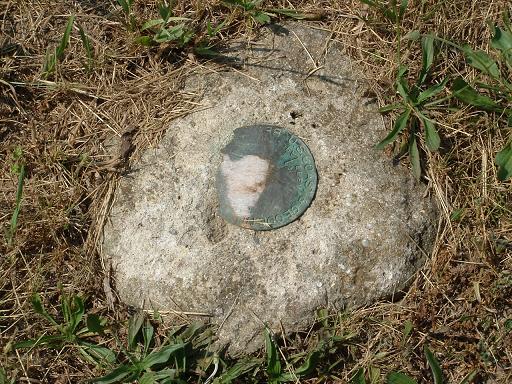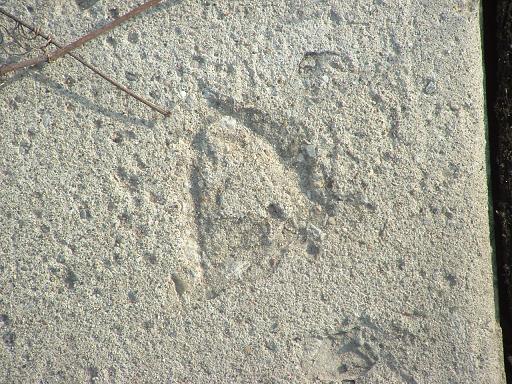It's spring here in Indiana...theoretically. You couldn't tell it by our weather lately, though. Snow, sleet, and generally about 20 degrees or so below normal. Of course, "normal" is pretty much defined as "the average of 10 abnormal years", so I expect that this year will go toward lowering the "normal" temperature a little bit in a few years.
Be that as it may, over the weekend we had some gorgeous weather, so we went out caching and benchmark hunting. Our first quarry was a National Geodetic Survey Benchmark disc in Auburn, Indiana.
Our first quarry was a National Geodetic Survey Benchmark disc in Auburn, Indiana.
The benchmark disc is stamped M22, but its official designation (called a PID) is MD0692.
This was a fairly easy find - its coordinates were almost exactly dead-on, and the description given by the NGS was more than enough to help us find it. The fact that the benchmark was on a small concrete "pillar" that jutted up from the ground about 3-4 inches, and was right next to a Witness Post sign didn't hurt, either!
We got some good, clear shots of the benchmark disc and went off to find our next target.
Here's our next target, which was a little more challenging. It too is an NGS benchmark disc, as you can see.
This one was also set in concrete, but the concrete has been there long enough that the surrounding soil has "grown up" to the level of the concrete.
The landowner spread mulch over the benchmark and around its witness post sign - presumably so he didn't have to mow around it! Benchmarks can be hard on lawnmower blades - and are equally vulnerable to being cut. Here's a picture of one we found last year. You can see the effect a lawnmower has had on THIS benchmark! That's why I think the owner of the land housing G198 was very smart to avoid the lawnmowing issue altogether.
Here's a picture of one we found last year. You can see the effect a lawnmower has had on THIS benchmark! That's why I think the owner of the land housing G198 was very smart to avoid the lawnmowing issue altogether.
The benchmark's stamp "name" is G198, but its PID is MD0933. They always stamp the "name" and the year it was placed in the middle of the benchmark. The year helps to determine, on occasion, if the disc is even still there! One we hunted this weekend was completely missing - we couldn't find any indication whatsoever of a disc. Since it was on the wingwall of a fairly well-maintained bridge, we were fairly certain that if it had been there, we would have found it. There were no structures or plants obstructing our view (yet), so we concluded that it was missing. A plaque on the bridge gave us our final clue - the benchmark disc had been placed in 1968, but the bridge itself had been completely replaced in 1970. We concluded that the benchmark was very likely removed and destroyed at the time of the old bridge's destruction. Our final benchmark was one that was placed by the Indiana Department of Natural Resources, Water Division. While there are coordinates for the NGS benchmarks, which can be found at http://www.geocaching.com/mark/, the Indiana DNR database contains only descriptions of their benchmarks and their locations. We've really started to enjoy hunting the Indiana DNR benchmarks. It's like letterboxing, only without the box at the end! It's quite challenging, and stretches our hunting and clue-reading abilities to the limit at times.
Our final benchmark was one that was placed by the Indiana Department of Natural Resources, Water Division. While there are coordinates for the NGS benchmarks, which can be found at http://www.geocaching.com/mark/, the Indiana DNR database contains only descriptions of their benchmarks and their locations. We've really started to enjoy hunting the Indiana DNR benchmarks. It's like letterboxing, only without the box at the end! It's quite challenging, and stretches our hunting and clue-reading abilities to the limit at times.
We had not realized how very small some of these marks are, either. This triangle, for example, is approximately 2 inches per side, tops. Not exactly easy to find when you're looking for something chiseled in concrete, that may or may not have been worn down by the weather in the meantime!
We really enjoy looking for Benchmarks. They're useful, interesting, and many of them have histories. We've learned that benchmarks can be many things - not only discs, but chiseled marks in concrete, church spires, courthouse domes and even railroad spikes.
We're looking forward to our next benchmark hunt.
See you on the trails, the bridges, and the courthouse lawns!
Monday, March 31, 2008
Cabin Fever! Spring Fever! OUT!
Posted by
Kim
at
6:05 AM
Labels: benchmarks, DogMom
Subscribe to:
Post Comments (Atom)
No comments:
Post a Comment